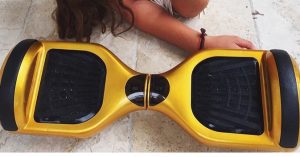[ot-caption title=”Hoverboards: the latest in transportation technology (via Jorgen Haland/Flickr). “]
Back in 1985, when Michael J. Fox graced the silver screen as Marty McFly in Back to the Future, it didn’t seem unrealistic that in 30 years the world would have flying cars, self-lacing sneakers, and (most importantly) hoverboards. Last week was the highly anticipated date that Marty traveled to in the future: October 21, 2015. Some of Marty’s expectations for the future were definitely outlandish, however, there is a growing trend of handless, segway-like devices that are being dubbed “hoverboard.” They are receiving a lot of attention from celebrities and the press, having other creators on a mission to create actual hovering skateboards.

These commercially available devices have been deemed as unnecessary, personal transportation vehicles, but they have gained major traction from endorsement of numerous celebrities and late night television shows. They offer a gliding sensation without having to make a single step. First marketed as a niche, luxury vehicle, the initial retail price was $1499 or higher from firms like PhunkeeDuck and IO Hawk. With popular videos made by bloggers, such as Casey Neistat, on YouTube garnering four million views, it became evident that there was one Chinese manufacturer selling these handless segways at a fraction of the price; these other companies were just relabeling and repackaging, while exorbitantly raising the price. Now, you can quickly search Amazon or Alibaba and purchase one virtually identical product to its $1499 counterpart at around $299. While these are the most consumer accessible products, the likes of Lexus and Arx Pax are attempting to bring to life the promise of the Back to the Future trilogy.

Taking two drastically different approaches, Lexus and Arx Pax both are vying for a position as the company that can produce the first true hoverboard. In a strange advertising campaign, car manufacturer Lexus uses liquid nitrogen to super cool superconductor blocks that would run on a magnetic track to levitate their skateboard. This hoverboard called the Slide was demoed at some key locations for members of the press with no commercial viability on the horizon. In contrast, Arx Pax, a corporation centered around a magnetic field technology, constructs the Hendo Hoverboard that employs four engines that have special magnetic fields that interact with the metal surface of the ramp on which the skateboard is ridden to make it float. Even while Arx Pax does seem more determined to create a consumer product, the Hendo Hoverboard does not appear to being released to public markets anytime soon.
For now, the most accessible and least expensive way to feel like Marty McFly is to buy a handless segway on Amazon and be content with “hovering” along at 6 miles per hour. The demonstrations by Arx Pax and Lexus seem like long shots, with major flaws, because of the necessities of metal ramps and liquid nitrogen cooling, respectively. Regardless, it is past October 21, 2015, and while we do have supercomputer phones and virtual reality headsets, the idea of hovering skateboards and self-lacing sneakers may still be a bit too premature.
































![Stranger Things 4: What to Expect [Warning: Contains Spoilers]](https://pcpawprint.com/wp-content/uploads/2021/11/StrangerThings4-900x473.jpeg)


































































